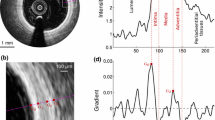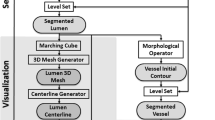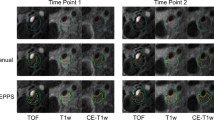Abstract
Atherosclerosis leads to heart attack and stroke, which are major killers in the western world. These cardiovascular events frequently result from local rupture of vulnerable atherosclerotic plaque. Non-invasive assessment of plaque vulnerability would dramatically change the way in which atherosclerotic disease is diagnosed, monitored, and treated. In this paper, we report a computerized method for segmentation of arterial wall layers and plaque from high-resolution volumetric MR images. The method uses dynamic programming to detect optimal borders in each MRI frame. The accuracy of the results was tested in 62 T1-weighted MR images from six vessel specimens in comparison to borders manually determined by an expert observer. The mean signed border positioning errors for the lumen, internal elastic lamina, and external elastic lamina borders were −0.1 ± 0.1, 0.0 ± 0.1, and −0.1 ± 0.1 mm, respectively. The presented wall layer segmentation approach is one of the first steps towards non-invasive assessment of plaque vulnerability in atherosclerotic subjects.
Similar content being viewed by others
References
Lauer RM, Clarke WR. The use of cholesterol measurements in childhood for the prediction of adult hypercholesterolemia: the Muscatine study. JAMA 1990; 264: 3034–3038.
Burns TL, Moll PP, Lauer RM. Increased familial cardiovascular mortality in obese school children: the Muscatine ponderosity family study. Pediatrics 1992; 89: 262–268.
Brejl M, Sonka M. Object localization and border detection criteria design in edge-based image segmentation: automated learning from examples. IEEE Trans Med Imaging 2000; 19: 973–985.
Zhang X, McKay CR, Sonka M. Image segmentation and tissue characterization in intravascular ultrasound. IEEE Trans Med Imaging 1998; 17: 889–899.
Stähr PM, Höfflinghaus T, Voigtländer T, et al. Discrimination of early/intermediate and advanced/complicated coronary plaque types by radio frequency intravascular ultrasound analysis. Am J Cardiol 2002; 90(July): 19–23.
Wahle A, Prause GPM, DeJong SC, Sonka M. Geometrically correct 3–D reconstruction of intravascular ultrasound images by fusion with biplane angiography - methods and validation. IEEE Tran Med Imaging 1999; 18(August): 686–699.
Wahle A, Prause GPM, von Birgelen C, Erbel R, Sonka M. Fusion of angiography and intravascular ultrasound in vivo: establishing the absolute 3–D frame orientation. IEEE Trans Biomed Eng - Biomed Data Fusion 1999; 46(October): 1176–1180.
Fujimoto J, Boppart S, Tearney G, Bouma B, Pitris C, Brezinski M. High resolution in vivo intraarterial imaging with optical coherence tomography. Heart 1999; 82: 128–133.
Agatston AS, Janowitz WR, Hildner FJ, Zusmer NR, Viamonte M, Detrano R. Quantification of coronary artery calcium using ultrafast computed tomography. J Am Coll Cardiol 1990; 15: 827–832.
Rumberger JA, Behrenbeck T, Breen JF, Sheedy PF. Coronary calcification by electron beam computed tomography and obstructive coronary artery disease: a model for costs and effectiveness of diagnosis as compared with conventional cardiac testing methods. J Am Coll Cardiol 1999; 33: 453–462.
Schroeder S, Kopp AF, Ohnesorge B, et al. Accuracy and reliability of quantitative measurements in coronary arteries by multi-slice computed tomography: experimental and initial clinical results. J Am Coll Cardiol 2001; 37: 1430–1435.
Touissant JF, LaMuraglia GM, Southern JF. Magnetic resonance images lipid, fibrous, calcified, hemorrhagic, and thrombotic components of human atherosclerosis in vivo. Circulation 1996; 94: 932–938.
Yuan SX, Zhang C, Polissar NL, et al. Identification of fibrous cap rupture with magnetic resonance imaging is highly associated with recent transient ischemic attack or stroke. Circulation 2002; 105: 181–185.
Yuan C, Tsuruda JS, Beach KN, et al. Techniques for high-resolution MR imaging of atherosclerotic plaque. J Magn Reson Imaging 1994; 4: 43–49.
Luk-Pat G, Gold G, Olcott E, Hu B, Nishimura D, High-resolution three-dimensional in vivo imaging of atherosclerotic plaque. Magn Reson Med 1999; 42(October): 762–771.
Fayad Z, Nahar T, Fallon J, et al. In vivo magnetic resonance evaluation of atherosclerotic plaques in the human thoracic aorta: a comparison with transesophageal echocardiography. Circulation 2000; 101(May); 2503–2509.
Fayad Z, Fuster V, Fallon J, et al. Noninvasive in vivo human coronary artery lumen and wall imaging using black-blood magnetic resonance imaging. Circulation 2000; 102 (August); 506–510.
Sonka M, Thedens DR, Schulze-Bauer C, et al. Towards MR assessment of plaque vulnerability: image acquisition and segmentation, In: 10th Scientific Meeting of the International Society for Magnetic Resonance in Medicine. Berkeley, CA: ISMRM 2002; 1570.
Sonka M, Hlavac V, Boyle R. Image Processing, Analysis, and Machine Vision. 2nd ed. Pacific Grove, CA: PWS, 1998. (1st ed. Chapman and Hall, London, 1993).
Sonka M, Fitzpatrick JM, editors. Handbook of Medical Imaging. Medical Image Processing and Analysis, Vol. 2 Bellingham WA: SPIE 2000.
Schulze-Bauer CAJ, Auer M, Stollberger R, Regitnig P, Sonka M, Holzapfel GA. Assessment of plaque stability by means of high-resolution MRI and finite element analyses of local stresses and strains. In: Proceedings of 2002 International Symposium on Biomedical Imaging, CD-ROM. Los Alamitos, CA: IEEE 2002; pp. TACS-4.1.
Hughes TJR. The Finite Element Method: Linear Static and Dynamic Finite Element Analysis. Englewood Cliffs, New Jersey: Prentice-Hall, 1987.
Holzapfel GA. Nonlinear Solid Mechanics. A Continuum Approach for Engineering. Chichester: John Wiley & Sons, 2000.
Holzapfel GA, Gasser TC, Ogden RW. A new constitutive framework for arterial wall mechanics and a comparative study of material models. J Elasticity 2000; 316: 1–48.
Holzapfel GA, Gasser TC, Stadler M. A structural model for the viscoelastic behavior of arterial walls: continuum formulation and finite element analysis. Eur J Mech A - Solids 2002; 21: 441–463.
Holzapfel GA, Ogden RW, editors. Biomechanics of Soft Tissue in Cardiovascular Systems. Wien, New York: Springer-Verlag, 2003.
Holzapfel GA, Schulze-Bauer CAJ, Stadler M. Mechanics of angioplasty: wall, balloon and stent. In: Casey J, Bao G, editors. Mechanics in Biology. New York: The American Society of Mechanical Engineers (ASME), 2000; AMD-Vol. 242/BED-Vol. 46: 141–156.
Holzapfel GA, Stadler M, Schulze-Bauer CAJ. A layerspecific three-dimensional model for the simulation of balloon angioplasty using magnetic resonance imaging and mechanical testing. Anals Biomed Eng 2002; 30: 753–767.
Correia LC, Atalar E, Kelemen MD, et al. Intravascular magnetic resonance imaging of aortic atherosclerotic plaque composition. Arterioscler Thromb Vas Biol 1997; 17(December): 3626–3632.
Yuan C, Mitsumori LM, Beach KW, Maravilla KR. Carotid atherosclerotic plaque: noninvasive MR characterization and identification of vulnerable lesions. Radiology 2001; 221: 285–299.
Botnar RM, Kim WY, Bornert P, Stuber M, Spuentrup E, Manning WJ. 3D coronary vessel wall imaging utilizing a local inversion technique with spiral image acquisition. Magn Reson Med 2001; 46: 848–854.
Yuan C, Kerwin WS, Ferguson MS, et al. Contrast-enhanced high resolution MRI for atherosclerotic carotid artery tissue characterization. J Magn Reson Imaging 2002; 15: 62–67.
Fuster V, editor. The Vulnerable Atherosclerotic Plaque: Understanding, Identification, and Modification. American Heart Association. Armonk: Futura publishing company, 1999.
Loree HM, Kamm RD, Stringfellow RG, Lee RT. Effects of fibrous cap thickness on peak circumferential stress in model atherosclerotic vessels. Circ Res 1992; 71: 850–858.
Richardson PD, Davies MJ, Born GVR. Influence of plaque configuration and stress distribution on fissuring of coronary atherosclerotic plaques. Lancet 1989; 941–944.
Davies MJ, Richardson PD, Woolf N, Katz DR, Mann J. Risk of thrombosis in human atherosclerotic plaques: role of extracellular lipid, macrophage, and smooth muscle cell content. Br Heart J 1993; 69: 377–381.
American Heart Association. Heart Disease and Stroke Statistics - 2003 Update. Dallas, Texas: American Heart Association, 2002.
Escaned J, Cortes J, Alcocer MA, et al. Long-term angiographic results of stenting in chronic total occlusions: influence of stent design and vessel size. Am Heart J 1999; 138: 675–688.
Escaned J, Goicolea J, Alfonso F, et al. Propensity and mechanisms of restenosis in different coronary stent designs: complementary value of the analysis of the luminal gain- loss relationship. J Am Coll Cardiol 1999; 34: 1490–1497.
Garasic JM, Edelman ER, Squirem JC, Seifert P, Williams MS, Rogers C. Stent and artery geometry determine intimal thickening independent of arterial injury. Circulation 2000; 101: 812–818.
Ellis SG, Vandormael MG, Cowley MJ, et al. Coronary morphologic and clinical determinants of procedural outcome with angioplasty for multivessel coronary disease: implications for patient selection (Multivessel Angioplasty Prognosis Study Group). Circulation 1990; 82: 1193–1202.
Keane D, Azar AJ, de Jaegere P, et al. Clinical and angiographic outcome of elective stent implantation in small coronary vessels: an analysis of the BENESTENT trial. Semin Interv Cardiol 1996; 1: 255–262.
Stary HC, Chandler AB, Dinsmore RE, et al. A definition of advanced types of atherosclerotic lesions and a histological classification of atherosclerosis: a report from the committee on vascular lesions of the council on arteriosclerosis, american heart association. Circulation 1995; 92: 1355–1374.
Author information
Authors and Affiliations
Rights and permissions
About this article
Cite this article
Yang, F., Holzapfel, G., Schulze-Bauer, C. et al. Segmentation of wall and plaque in in vitro vascular MR images. Int J Cardiovasc Imaging 19, 419–428 (2003). https://doi.org/10.1023/A:1025829232098
Issue Date:
DOI: https://doi.org/10.1023/A:1025829232098




